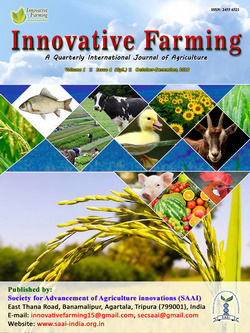
Antibiotic Sensitivity Pattern of the Isolated Lactic Acid Bacteria from Silkworm (Bombyx mori L.) Gut
Saranya. M.*
Department of Sericulture, Forest College and Research Institute, Mettupalayam, Tamil Nadu, INDIA
S. V. Krishnamoorthy
Department of Sericulture, Forest College and Research Institute, Tamil Nadu, INDIA
D. Balachandar
Department of Agrl. Microbiology, TNAU, Coimbatore, Tamil Nadu, INDIA
K. A. Murugesh
Department of Sericulture, Forest College and Research Institute, Tamil Nadu, INDIA
DOI: NIL
Keywords: Silkworm gut, Lactic acid bacteria, Antibiotics and Susceptibility
Abstract
Laboratory study was undertaken at the Department of Agricultural Microbiology, TNAU at Coimbatore to find out the sensitive pattern of lactic acid bacteria isolated from silkworm (Bombyx mori L.) gut. About 21 Lactic Acid Bacteria (LAB) isolates were isolated from silkworm gut of bivoltine double hybrid {(CSR6 x CSR26) X (CSR2 x CSR27). Susceptibility of the LAB isolates to antibiotics were performed by disc diffusion method. Overnight grown culture of each LAB isolate was spread evenly on the surface of MRS agar plate and allowed to dry. Antibiotic discs were then placed on LAB inoculated plates and incubated at 37°C for 24 hr. In this study, various antibiotics were supplied in the form of dodeca discs (Hi Media, India) which included Cefuroxime (30mcg), Cefaclor (30mcg), Ceftriaxone (30mcg), Cefalexin (30mcg), Ceftazidime (30mcg), Ceftizoxime (30mcg), Cefadroxil (30mcg), Ampicillin (30mcg), Cefaperazone (75mcg), Cefixime (5mcg) and Cefazolin (30mcg). The inhibition zone diameters of all antibiotics were between 0 and 30 mm for LAB strains isolated and tested after incubation at 37°C for 24 hr. Results were expressed as sensitive (S, ≥ 21 mm), intermediate (I, 16-20mm) and resistant (R, ≤ 15 mm). From total isolates, about 8 LAB isolates (SWGL 1, SWGL 4, SWGL 7, SWGL 9, SWGL 12, SWGL13, SWGL 16 and SWGL 17) were resistant to Cefixime, Cefaperazone, Cefadroxil and Ceftazidime. Six nos. of LAB strains were highly resistant to Cefaclor (SWGL 2, SWGL 3, SWGL 5 and SWGL 6), seven nos. to Ampicillin (SWGL 1, SWGL 3, SWGL 7, SWGL 9, SWGL 14, SWGL 16, SWGL 20 and SWGL 21) and two were intermediate to Ceftriaxone (SWGL 5 and SWGL 12). Three LAB isolates (SWGL 10, SWGL 14 and SWGL 15) were found sensitive to all three antibiotics (Cefazolin, Cefuroxime and Cefalexin). These isolates found to be sensitive to most of the antibiotics tested support for transferring antibiotic resistance genes to pathogenic microbes. They may also be incorporated as a feed for growth and development of silkworm.
Downloads
not found
Reference
Klein, G., A. Pack, C. Bonaparte and G. Reuter. 1998. Taxonomy and physiology of probiotic lactic acid bacteria. International Journal of Food Microbiology, 41(2): 103-125.
Phillips, Ian, Casewell Mark, Cox, Tony, Groot De, Brad, Friis Christian, Jones Ronald, Nightingale, Charles, Preston, Rodney and Waddell, John. 2004. Does The use of antibiotics in food animals pose a risk to human health. A critical review of published data. Journal of Antimicrobial Chemotherapy, 54(1): 76-278.
Radhakrishna Rai and M.C. Devaiah. 1988. Effect of antibiotics on the incidence of diseases in silkworm, Bombyx mori L. In: Proceedings of the International Congress on Tropical Sericulture, Bangalore, pp. 69-72.
Rahmathulla, V.K., Nayak, Padmanav, G.S. Vindya, M.T. Himantharaj and R.K. Rajan. 2003. Effect of antibiotic (norfloxacin) administration on commercial characters of new bivoltine and cross breed hybrid silkworm (Bombyx mori). International Journal of Industrial Entomology, 7(2): 191-195.
Resende, J.A., V.L. Silva, T.L. R. De Olivcira, F.S. De Olivcira, M.H. Carnciro and Otenio. 2014. Prevalence and persistence of potentially pathogenic and antibiotic resistance bacteria during anaerobic digestion treatment of cattle manure. Biotechnology, 153: 284-291.
Subramanian, S and P. Mohanraj. 2009. Antibacterial activity of gut flora isolates from mulberry silkworm Bombyx mori L. The Bioscan (special issue).
Tayade, D.S., M.D. Jawale and P.K. Unchegaonkar. 1988. Effect of antibiotic on the growth of silkworm Bombyx mori L., Indian Journal of Sericulture, 27(2): 69-72.
Vankerckhoven, V., G. Huys, M. Vancanneyt, C. Vael, I. Klare and M.B. Romomd. 2008. Biosafety assessment of probiotic used for human consumption: recommendations from the EU-PROSAFE project. Trends in Food Science Technology, 19: 102-114.
Venkatesh Kumar, R. and Amit Srivastava. 2010. Relevance of antibiotics with reference to sericulture industry. International Journal of Science and Nature, 1(2): 97-100.
Yeung P.S.M., M.E. Sanders, C.L. Kitts, R. Cano and P.S. Tong. 2002. Species specific identification of commercial probiotic strains. Journal of Dairy Science Association, 85: 1039-1051.
